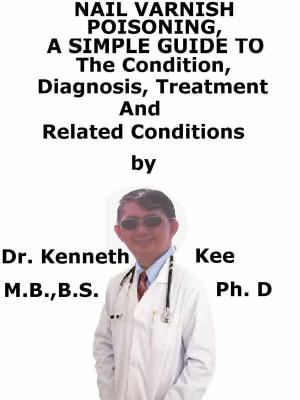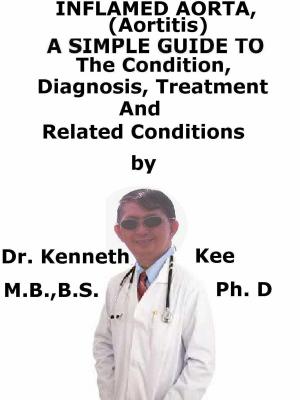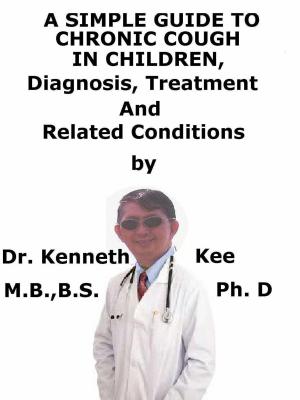Frost Bite Injury A Simple Guide To The Condition, Diagnosis, Treatment And Related Conditions
Nonfiction, Health & Well Being, Health, Ailments & Diseases, Skin, Medical, Specialties, Orthopedics| Author: | Kenneth Kee | ISBN: | 9781370341689 |
| Publisher: | Kenneth Kee | Publication: | October 30, 2017 |
| Imprint: | Smashwords Edition | Language: | English |
| Author: | Kenneth Kee |
| ISBN: | 9781370341689 |
| Publisher: | Kenneth Kee |
| Publication: | October 30, 2017 |
| Imprint: | Smashwords Edition |
| Language: | English |
Frostbite is the condition of injury to the skin and underlying tissues caused by extreme cold.
Frostbite is the most frequent freezing injury.
Frostbite is an injury that is induced by exposure of parts of the body to temperatures below freezing point.
The cold produces freezing of the skin and underlying tissues.
The fingers, toes and feet are most often involved but other extremities, such as the nose, ears and cheeks, can also form frostbite.
Causes
Frostbite happens when the skin and body tissues are exposed to cold temperature for a long period of time.
The patient tends more likely to develop frostbite if he or she:
1. Takes medicines called beta-blockers
2. Has poor blood supply to the legs
3. Smoke
4. Has diabetes
5. Has Raynaud syndrome
Normally the blood transports oxygen to all parts of the body so that the body tissues are maintained healthy.
During a protective response when the body has exposure to extreme cold, the blood vessels narrow (constrict) so that blood (and oxygen) are transferred away from the extremities to the vital organs to keep the body alive.
After a while, this inadequate blood supply and oxygen to the skin can begin to produce injury to the cells.
In the parts of the body involved by frostbite, the ice crystals form and cells and blood vessels become injured.
Blood clots can also develop in small blood vessels which will decrease the possibility of blood and oxygen getting to the affected tissues.
The probability of frostbite is raised when the patient has longer exposure to the cold temperatures.
Risk factors
Frostbite is not frequent.
Frostbite most often involves these groups of people:
1. Soldiers.
2. People who work outdoors in the cold.
3. Homeless people.
4. Winter outdoor sports people such as skiers and climbers.
5. Alcohol may make the drunk less obvious to the cold and hence develop frostbite
The different degrees of frostbite
1. First-degree frostbite just involves the epidermis.
2. Second-degree frostbite may involve the epidermis and part of the dermis.
3. Third-degree frostbite involves the epidermis, the dermis and the fatty tissue beneath the dermis.
4. Fourth-degree frostbite occupies the entire thickness of the skin, the tissues that are below the skin, and also the deeper tissues such as muscles, tendons and bone.
Symptoms of frostbite may be:
1. Pins and needles feeling, followed by numbness
2. Hard, pale, and cold skin that has been exposed to the cold for too long
3. Aching, throbbing or lack of feeling in the affected area
4. Red and extremely painful skin and muscle as the area thaws
Very severe frostbite may cause:
1. Blisters
2. Gangrene (blackened, dead tissue)
3. Damage to tendons, muscles, nerves, and bone
Diagnosis:
Frostbite is normally diagnosed by the normal features in someone who has been exposed to extreme, cold weather.
Scintigraphy and Bone Scans are occasionally used to evaluate the degree of frostbite and to determine how much tissue is injured
Treatment
The basic first aid for frostbite injuries is:
1. Shelter the person from the cold and move him or her to a warmer place.
2. Change wet clothing for dry clothing.
3. Keep the involved area air dry and wrapped
4. Try to make sure that the person is re-hydrated.
Give warm water to drink
Rapid re-warming can be done using heated water which should be kept at 37-39°C for 30 minutes
Re-warming can be very painful, hence anti-inflammatory painkillers are also given
Some 'clot-busting' medicines (thrombolytics) may be given in cases of deep frostbite to attempt to improve the blood supply to the involved area.
Surgery is required to remove dead tissue -debridement of injured tissue and amputation of dead fingers or toes
TABLE OF CONTENT
Introduction
Chapter 1 Frostbite
Chapter 2 Causes
Chapter 3 Symptoms
Chapter 4 Diagnosis
Chapter 5 Treatment
Chapter 6 Prognosis
Chapter 7 Cold Injury
Chapter 8 Hypothermia
Epilogue
Frostbite is the condition of injury to the skin and underlying tissues caused by extreme cold.
Frostbite is the most frequent freezing injury.
Frostbite is an injury that is induced by exposure of parts of the body to temperatures below freezing point.
The cold produces freezing of the skin and underlying tissues.
The fingers, toes and feet are most often involved but other extremities, such as the nose, ears and cheeks, can also form frostbite.
Causes
Frostbite happens when the skin and body tissues are exposed to cold temperature for a long period of time.
The patient tends more likely to develop frostbite if he or she:
1. Takes medicines called beta-blockers
2. Has poor blood supply to the legs
3. Smoke
4. Has diabetes
5. Has Raynaud syndrome
Normally the blood transports oxygen to all parts of the body so that the body tissues are maintained healthy.
During a protective response when the body has exposure to extreme cold, the blood vessels narrow (constrict) so that blood (and oxygen) are transferred away from the extremities to the vital organs to keep the body alive.
After a while, this inadequate blood supply and oxygen to the skin can begin to produce injury to the cells.
In the parts of the body involved by frostbite, the ice crystals form and cells and blood vessels become injured.
Blood clots can also develop in small blood vessels which will decrease the possibility of blood and oxygen getting to the affected tissues.
The probability of frostbite is raised when the patient has longer exposure to the cold temperatures.
Risk factors
Frostbite is not frequent.
Frostbite most often involves these groups of people:
1. Soldiers.
2. People who work outdoors in the cold.
3. Homeless people.
4. Winter outdoor sports people such as skiers and climbers.
5. Alcohol may make the drunk less obvious to the cold and hence develop frostbite
The different degrees of frostbite
1. First-degree frostbite just involves the epidermis.
2. Second-degree frostbite may involve the epidermis and part of the dermis.
3. Third-degree frostbite involves the epidermis, the dermis and the fatty tissue beneath the dermis.
4. Fourth-degree frostbite occupies the entire thickness of the skin, the tissues that are below the skin, and also the deeper tissues such as muscles, tendons and bone.
Symptoms of frostbite may be:
1. Pins and needles feeling, followed by numbness
2. Hard, pale, and cold skin that has been exposed to the cold for too long
3. Aching, throbbing or lack of feeling in the affected area
4. Red and extremely painful skin and muscle as the area thaws
Very severe frostbite may cause:
1. Blisters
2. Gangrene (blackened, dead tissue)
3. Damage to tendons, muscles, nerves, and bone
Diagnosis:
Frostbite is normally diagnosed by the normal features in someone who has been exposed to extreme, cold weather.
Scintigraphy and Bone Scans are occasionally used to evaluate the degree of frostbite and to determine how much tissue is injured
Treatment
The basic first aid for frostbite injuries is:
1. Shelter the person from the cold and move him or her to a warmer place.
2. Change wet clothing for dry clothing.
3. Keep the involved area air dry and wrapped
4. Try to make sure that the person is re-hydrated.
Give warm water to drink
Rapid re-warming can be done using heated water which should be kept at 37-39°C for 30 minutes
Re-warming can be very painful, hence anti-inflammatory painkillers are also given
Some 'clot-busting' medicines (thrombolytics) may be given in cases of deep frostbite to attempt to improve the blood supply to the involved area.
Surgery is required to remove dead tissue -debridement of injured tissue and amputation of dead fingers or toes
TABLE OF CONTENT
Introduction
Chapter 1 Frostbite
Chapter 2 Causes
Chapter 3 Symptoms
Chapter 4 Diagnosis
Chapter 5 Treatment
Chapter 6 Prognosis
Chapter 7 Cold Injury
Chapter 8 Hypothermia
Epilogue















